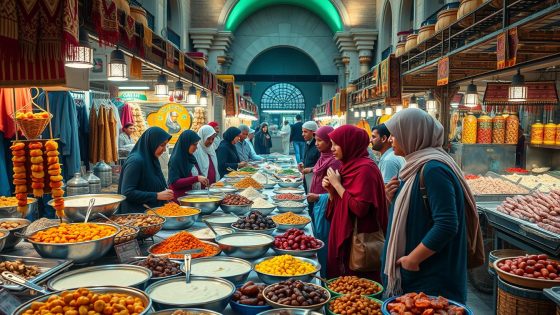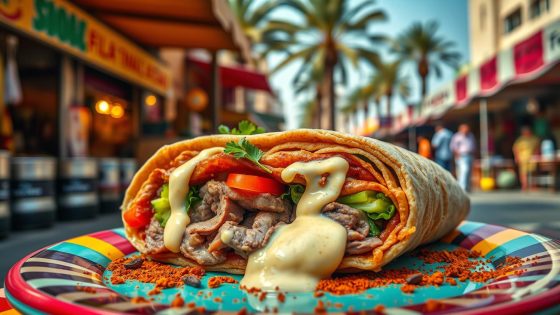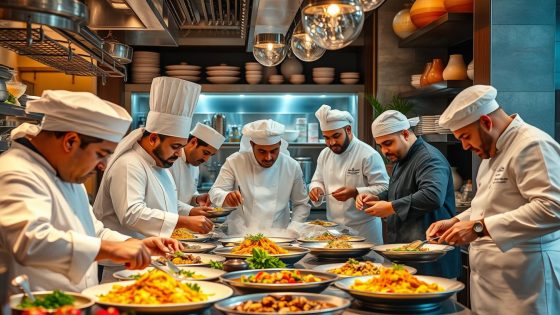Contents
Exploring UAE cuisine is a must for food-loving travelers. Many tourists have common queries about local dishes and dining customs. Let’s dive into some frequently asked questions about the vibrant food scene in this Gulf nation.
Visitors often wonder about must-try local foods and vegetarian options. They’re curious about dining etiquette and how to find authentic Emirati restaurants. Food safety concerns and dietary restrictions are other common topics.
The UAE’s culinary landscape is diverse, blending traditional Arab and Persian flavors with international influences. Dubai, a foodie paradise, hosts an annual Food Festival showcasing the city’s gastronomic variety. With an average daily food cost of $86 per person, tourists can savor everything from street food to luxury dining experiences.
For those on a budget, meals range from $15 for breakfast to $69 for dinner. Mid-range travelers spend about $286 per day, while luxury seekers might shell out $750. These travel food tips help tourists plan their culinary adventures in the UAE.
Popular Questions About Emirati Dishes
As culinary tourism grows in the UAE, tourists often seek food advice to enhance their dining experiences. The unique flavors of Emirati cuisine spark curiosity among visitors, leading to many questions about local dishes. This cuisine tips guide aims to answer common queries and provide a comprehensive tourist dining guide.
What are must-try local foods?
Emirati cuisine offers a rich tapestry of flavors that reflect the country’s cultural heritage. For an authentic taste of the UAE, consider these popular dishes:
- Al Harees: A hearty dish of wheat and meat, slow-cooked to perfection
- Al Majboos: Spiced rice with meat, similar to biryani
- Shawarma: Succulent meat wrapped in flatbread with vegetables
- Luqaimat: Sweet dumplings drizzled with date syrup
- Khameer: Traditional Emirati bread, often served with cheese or honey
Are there vegetarian-friendly options?
While Emirati cuisine traditionally features meat, vegetarian options are available. Many restaurants now cater to diverse dietary preferences, offering plant-based versions of classic dishes. Here are some vegetarian-friendly choices:
| Dish | Description | Main Ingredients |
|---|---|---|
| Hummus | Creamy chickpea dip | Chickpeas, tahini, olive oil |
| Fattoush | Refreshing salad | Mixed vegetables, toasted bread |
| Moutabel | Smoky eggplant dip | Eggplant, tahini, garlic |
| Falafel | Deep-fried chickpea balls | Chickpeas, herbs, spices |
Remember to communicate your dietary restrictions clearly when dining out. Many restaurants in tourist areas are accustomed to accommodating various dietary needs, ensuring a pleasant culinary experience for all visitors.
Dining Etiquette in UAE
Understanding dining customs in the UAE is crucial for tourists exploring Emirati cuisine. Food exploration questions often arise about proper behavior during meals. Let’s dive into some key etiquette tips to enhance your culinary experience.
Greeting and Mealtime Behavior
When joining a meal in the UAE, greet others with “As-salaam-alaikum,” meaning “peace be upon you.” This simple phrase shows respect and cultural awareness. During the meal, use your right hand for eating and passing food. It’s polite to accept offered beverages, even if you don’t plan to drink them.
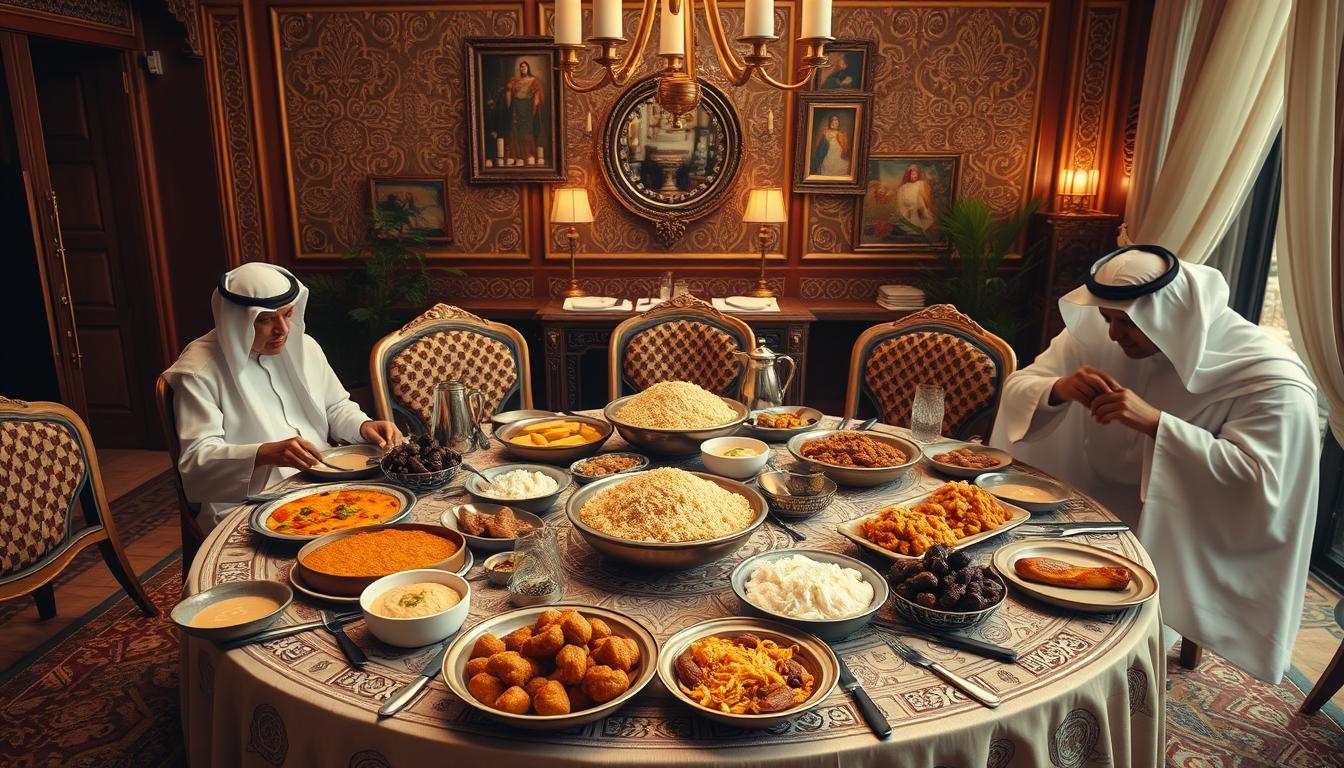
Common Customs to Follow
Tourist meal tips often emphasize dressing modestly, especially in conservative areas. Remove your shoes when entering homes. During Ramadan, avoid eating, drinking, or smoking in public during daylight hours out of respect for those fasting. Be mindful of prayer times and local customs.
- Dress modestly, covering knees and shoulders
- Use your right hand for eating and passing food
- Remove shoes when entering homes
- Respect Ramadan fasting hours in public
By following these guidelines, you’ll navigate Emirati dining situations with ease. Remember, culinary queries about local customs are welcome – locals often appreciate tourists’ efforts to understand their culture. Embrace these practices to fully enjoy your UAE food adventure.
Food Safety and Dietary Tips
Exploring UAE cuisine offers exciting dining experiences, but tourists should keep food safety in mind. Street food can be a delicious way to taste local flavors, yet caution is key. Choose busy stalls with high turnover for fresher options. Stick to bottled water and avoid raw or undercooked meats to stay healthy during your trip.
Street Food Safety
When trying street food, look for vendors with clean setups and proper food handling practices. Popular spots often mean safer choices. If you’re unsure, ask your hotel or tour guide for trusted recommendations. This approach helps you enjoy local treats while minimizing health risks.
Communicating Dietary Needs
For those with dietary restrictions, clear communication is crucial. Learn basic Arabic phrases related to your dietary needs or carry a translation card. Many restaurants, especially in tourist areas, can accommodate special diets if informed in advance.
| Dietary Need | Arabic Phrase | English Translation |
|---|---|---|
| Vegetarian | Ana nabati | I am vegetarian |
| Gluten-free | Bidoun gluten | Without gluten |
| Nut allergy | Ladaya hasasiya min al-mukassarat | I have a nut allergy |
Remember, during Ramadan, eating in public is discouraged for non-Muslims. Plan your meals accordingly and respect local customs. With these travel food tips, you can safely enjoy the diverse culinary landscape of the UAE.
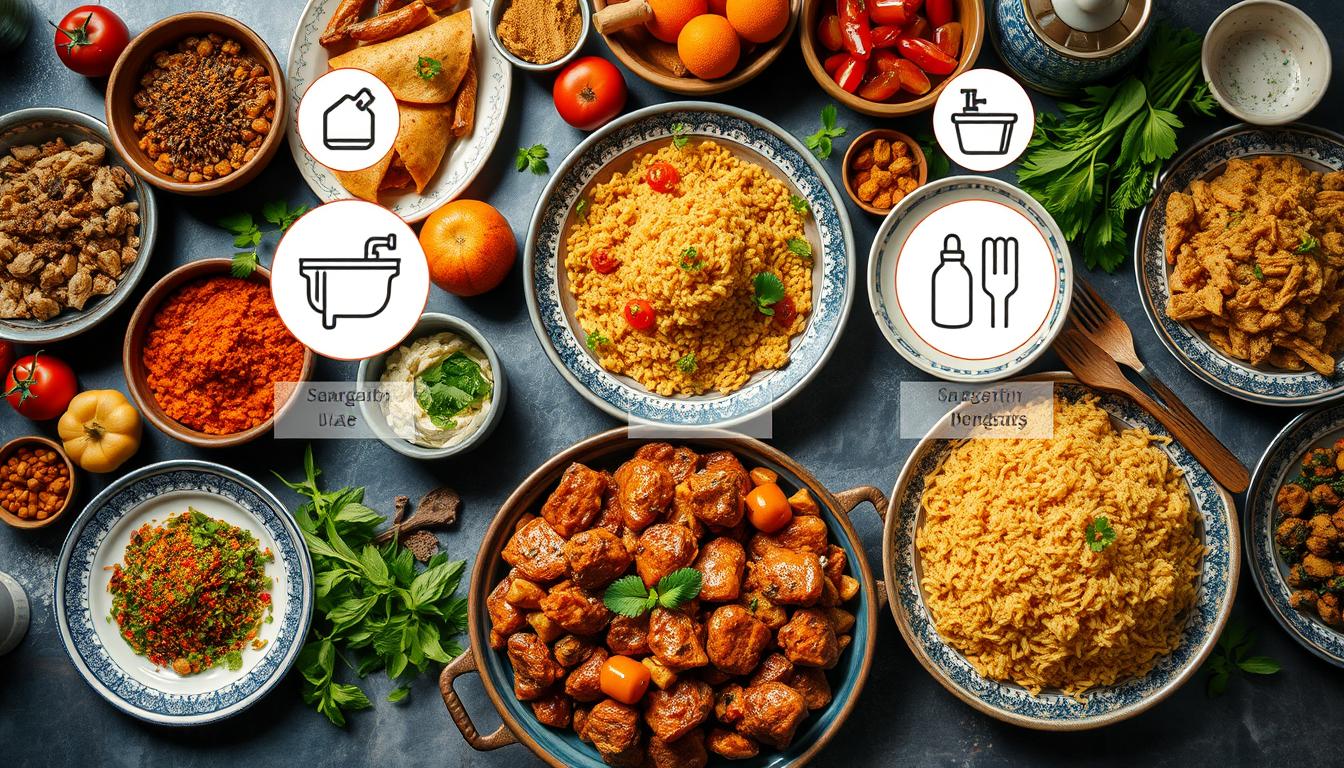
Finding Unique Food Experiences
Dubai’s culinary scene offers a feast for food lovers. From traditional Emirati dishes to international flavors, the city caters to all tastes. Let’s explore how to dive into this rich food culture and answer some common food exploration questions.
Where to experience authentic Emirati dining?
For a true taste of Emirati cuisine, head to old Dubai or Abu Dhabi. These areas host traditional restaurants serving local delicacies. A desert safari with a BBQ dinner under the stars is another great option. Prices for these unique dining experiences range from AED145 to AED1545 per person, fitting various budgets and preferences.
How to explore food festivals and markets?
The Dubai Food Festival is a must-visit for any culinary tourist. It features pop-up restaurants, cooking workshops, and food tastings. Local markets, or souks, offer a chance to buy spices, dates, and other local products. Guided food tours, lasting from 2 hours to half a day, provide insights into Dubai’s food scene and history. These tours often include multiple tastings and transport between food stops.
For a luxury experience, try a Michelin-starred restaurant or a special collaboration dinner. Tasting menu prices range from AED649 to AED995 per person. Unique options like Omakase dining cost between AED499 and AED599. Remember, this tourist dining guide is just the start of your culinary journey in the UAE. Happy eating!
